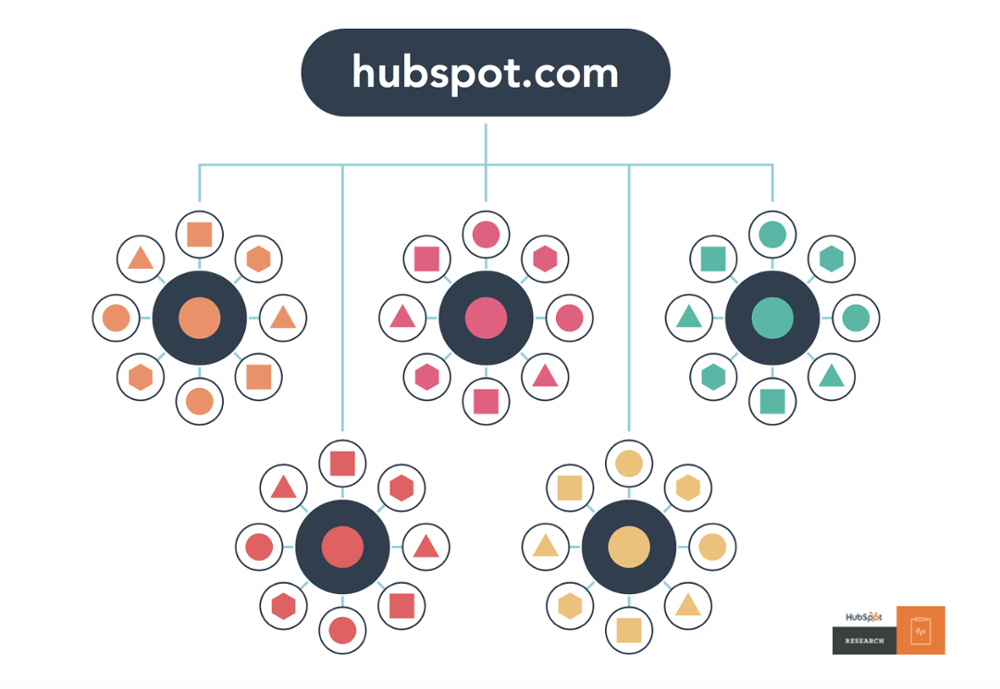Keywords. Those are what you previously based your web pages around. Long tail, descriptive keywords that summed up what you wanted users to find you by when using Google.
Today, that has changed. Keywords are still important, but they are evolving to adapt to ever changing search engines.
SEO is now switching to a topic cluster model. A single “pillar” page acts as the main hub of content for an overarching topic. Then, many content pages that are related to that same topic link back to the pillar page and to each other.
This linking action signals to search engines that the pillar page is an authority on the topic. Over time, the page may rank higher. The topic cluster model is a way of organizing a site’s content pages using a cleaner and more deliberate site architecture.
Keep reading to learn more about topics clusters.
WHAT ARE TOPIC CLUSTERS?
Topic clusters are an SEO strategy that focuses on topics instead of keywords.
Marketers are being forced to change their site’s architecture because search engines constantly change their algorithms in response to consumer’s behavior.
Before, when you were on Google, you may have searched, “Morgantown restaurants.” Nowadays, you may be searching, “Where should I eat for lunch?”
Search engines today are smart enough to recognize your intent.
Google’s 2013 Hummingbird update prompted the shift from keywords to the topic cluster model. This update began dissecting phrases instead of focusing merely on keywords.
Then, in 2015, Google introduced RankBrain. This is Google’s machine learning algorithm designed to understand the context of people’s search inquiries.
HUBSPOT AND TOPIC CLUSTERS
Because of these Google algorithm updates, HubSpot’s Anum Hussain and Cambria Davies started topic cluster experiments in 2016.
Their main takeaway was this: The more interlinking on a site, the better placement in search engine result pages (SERP). Impressions also increased with the higher number of links used.
WEBSITE ARCHITECTURE
Typically, with any website, you start with a homepage and then a blog. With each blog post, you target specific keywords. But, you soon realize that there are more than 1,000 long tail variations of that keyword. So, you’re left writing post after post to capture the search traffic. In the end, your site becomes repetitive and disorganized, which makes it harder for search engines to crawl your site.
With the topic cluster model, your site is rearranged to look more like the site below:
Clusters of content that cover a topic area link to a central pillar page that definitively, yet broadly, outlines the topic. When you link all internal content within a topic to a pillar page, search engines can easily scan all the content and understand that there is a semantic relationship between the pages’ content.
The topic cluster model also signals to search engines that there is a lot of depth in the content, giving the pillar page more authority on the topic.
TOPIC CLUSTER EXAMPLE
Let’s use the topic, “Personal Injury.”
All aspects of this topic would include:
- What is Personal Injury
- Car Accident Case
- Truck Accident Case
- Drunk Driving Accident
- Medical Malpractice
- Nursing Home Abuse
- Product Liability
- Work-related Accidents
- Hiring a Lawyer
- Filing a Lawsuit
Pillar pages need to broadly cover the topic you’re focusing on so that it makes sense to tie to all the cluster content linking to it. The cluster content you create or optimize should go into depth on just one area mentioned on the pillar page.
Think of pillar pages as a book and the cluster content as supporting chapters in the book. Keywords can still play into your overall strategy, but topics are now the umbrella under which your keyword strategy operates.
A topic cluster should contain at least 6-8 subtopics that address specific questions your potential customers may be exploring related to the core topic of your pillar page.
Keywords still remain as important as ever. When it comes to building out topic clusters though, the key is to create many pieces of content with different keyword phrases that all revolve around one central theme (topic).
To do that, we’ll need to select a core keyword topic for our pillar content and several related terms for other pieces of supporting content.
INNERACTION MEDIA | WEBSITE DEVELOPMENT
Staying ahead of the changing marketing landscape can be hard. We understand that, and that’s why we want to take the burden off you.
If your website needs refreshed to reflect today’s marketing best practices, give us a call. Our CEO, Jim Matuga, would be happy to engage in a free, 30-minute marketing consultation with you to see if we are a good fit.
If you’re losing traffic to competitors, it may be time for a change. Call us today to get started: 304-241-4959



